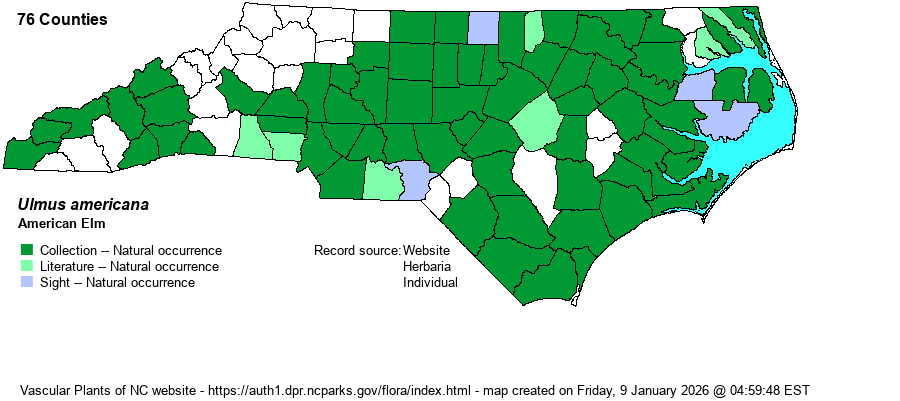| Author | L. | |
| Distribution | Essentially throughout the Piedmont and Coastal Plain, but scarce and local in the foothills; absent in much of the Mountains and apparently a few Piedmont foothills counties. The apparent absence over a considerable portion of the Mountains and foothills is surprising, given its range across nearly all counties in the eastern U.S. otherwise.
Occurs in nearly all counties in the eastern and central U.S. and southern Canada, south to southern FL and almost all of TX.
| |
| Abundance | Fairly common to common in the eastern and central Piedmont and western Coastal Plain. Infrequent in the cental and eastern Coastal Plain, though scarce near the coast. Absent in the Sandhills proper. Rare to locally uncommon in the southern Mountains and foothills. | |
| Habitat | This is a wetland species, typically occurring in bottomlands and on natural levees, less so in swamps. It favors brownwater sites as opposed to blackwater ones, but it is found along blackwater streams and rivers to some extent (as it occurs in nearly all coastal counties). When found in uplands, it usually occurs over high pH soils on lower slopes and flats; it is seldom found in strongly sloping ground. |
| Phenology | Flowers in February and March, and fruits shortly afterward –- in March and April. | |
| Identification | This is a very familiar deciduous tree, though to some this is due to their being planted on city streets, where subject to loss to Dutch elm disease. However, trees in more natural settings seldom succumb to the disease. It is a tall tree, often 80-90 feet tall, rarely over 100 feet; it has a distinctive vase-like array of branches, with the lower branches angled upward rather than spreading outward. This branching pattern is more obvious, however, when trees are in the open. The leaves are rather distinctive, except from Slippery Elm (Ulmus rubra), in that the leaf bases are asymmetrical, with one side being wider than the other. The leaves are widely elliptic, strongly serrate on the margins, and with distinctive parallel veins, typically with an acuminate tip; they average about 4 inches long. The upper surface typically is rather smooth and shiny, and is not scabrous. Slippery Elm leaves are a bit larger, less shiny above, and are strongly scabrous (“sandpaper-like”) on the upper surface. You should be able to identify this tree from the leaves and perhaps the growth form. The small fruit are flattened, elliptical, and have wings and fuzzy margins, and they mature in early spring; these can also help to identify the species. | |
| Taxonomic Comments | Weakley (2018) and a few other references list varieties for the species; most do not. According to that reference, the nominate form (U. americana var. americana) occurs over most of the state, whereas U. americana var. floridana occurs sparingly along the southern coast, found mainly on shell mounds and other calcareous forests (i.e., on high pH soils).
| |
| Other Common Name(s) | White Elm | |
| State Rank | S5 | |
| Global Rank | G5 | |
| State Status | | |
| US Status | | |
| USACE-agcp | FAC link |
| USACE-emp | FACW link |

